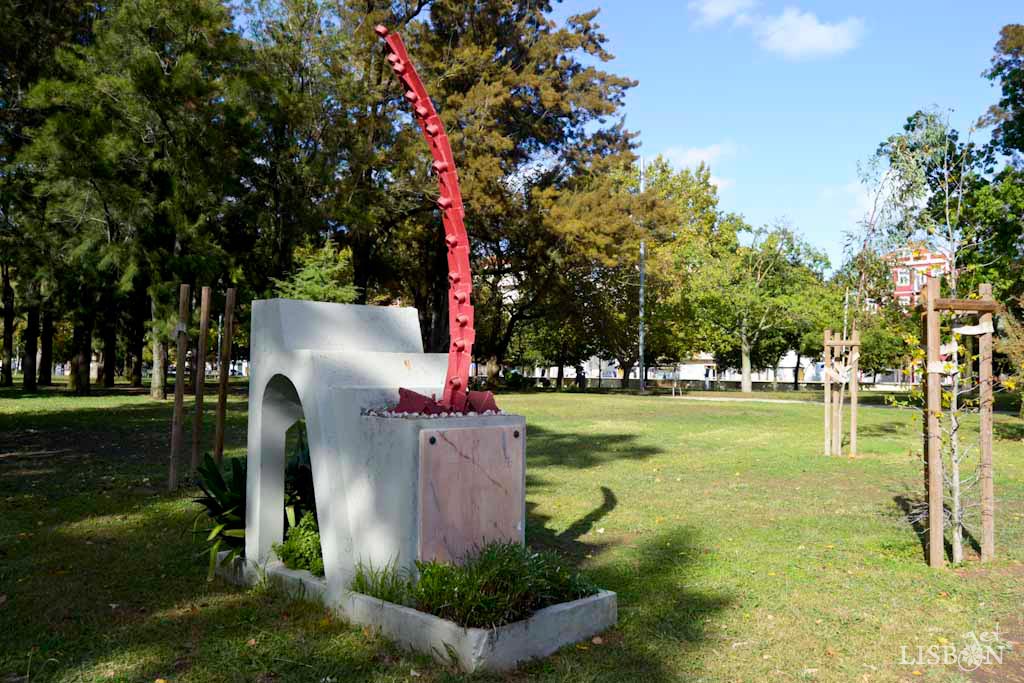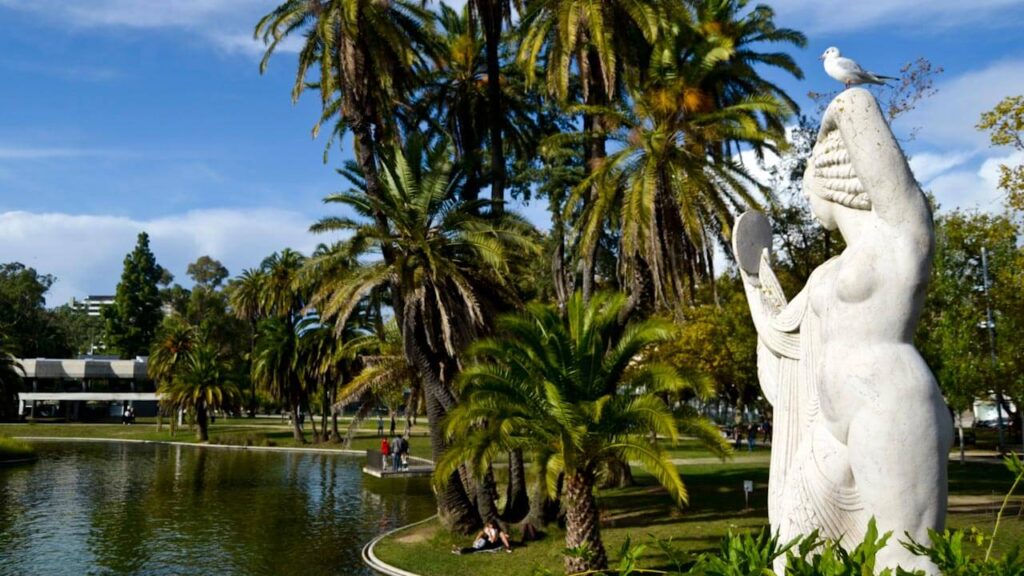Updated on 8 May 2024
Original article published on 23 September 2020
Do you have any clue of the diversity of the public art of the Campo Grande Garden in Lisbon? We’ve put together a route for you to see each of the art pieces there are in this pleasant and historic green space.
The Public Art of Campo Grande Garden
The Campo Grande Garden was renewed and named Mário Soares Garden in 2018, but it is still mostly known by its former name by the locals.
The renovation work at the time allowed restoring buildings and equipment, installing new resources and redrawing green spaces.
This extensive area of around 13 hectares divided by Brazil Avenue in two areas (north and south), became a very enjoyable and lively area.
We’ll begin our public art of Campo Grande Garden route on the north end, next to the Museum of Lisbon.
Get to know Lisbon’s historic neighbourhoods in a guided tour and discover unmissable places of this magnificent city.
Statues of King Afonso Henriques and King João I

Here are two big stone sculptures that are portraits of the first king of Portugal and the founder of the House of Aviz.
However, this is not their original location.
They were produced in 1950 by the sculptor Leopoldo de Almeida (1898-1975) to be placed in the atrium of the Lisbon City Hall, where they stayed until the big fire of 1996.
In the following year they were transferred by the City Council to their current location and reinaugurated on August 31.
Leopoldo de Almeida was also the author of the statues of Oliveira Martins and António Feliciano de Castilho, that we’ve referred to in the two articles about the Sculptures of Liberdade Avenue.
Bust of Rafael Bordalo Pinheiro

Right in front of the Bordalo Pinheiro Museum we can observe a monument of tribute to the artist.
The bust has a square-shaped decorated bronze base and is supported by a stone plinth that features a bronze palm.
The decoration takes us to the plastic artist’s universe. On the front side there’s a representation of the Republic, on the back side the figure of Zé Povinho (a character created by Bordalo Pinheiro in 1875 that became the symbol of modest Portuguese people) and on the sides there are cats.
This piece, inaugurated on March 20, 1921 is from the young sculptor at the time Raul Xavier (1894-1964) and the architect José Alexandre Soares.
It reveals influence from Raul’s master Costa Motta (Tio). Later on he adopted a more modernist aesthetic, which can be seen for example in the statue of Saint Vincent in Portas do Sol Viewpoint, Alfama.
Read about two of the projects of the architect José Alexandre Soares: the bandstand of José Fontana Square, built in the late 1880s and the WC kiosk of Lisbon of 1913.
Relief Ceramic Panel

Let’s walk south towards the Caleidoscópio Building. Its façade presents the largest art piece of all the public art of Campo Grande Garden. A panel from the ceramist Maria Emília Silva Araújo (1940), which was already featured in our article 5 Relief Ceramic Panels in Lisbon.


Geodesic Marker BIP/ZIP

Behind the Caleidoscópio Building, we can observe a sculpture by the multifaceted designer and artist Rui A. Pereira (1966). This is a commemorative piece for the 10 years of BIP/ZIP, a program by the municipality aimed at implementing, in collaboration with local communities, small improvements in municipal housing neighbourhoods.
This parallelepiped-shaped sculpture features, on two of its parallel faces, the BIP/ZIP Program logo, and on the other two, descriptions related to the program and bas-reliefs that refer to figurative and vegetal elements.
Inaugurated on April 19, 2021, it serves as a geodesic marker for the Program, where from the QR Code on the explanatory plaque, it is possible to trace the footsteps of the interventions carried out over the years.
Sculptures of Casa do Lago
Further ahead there is the peculiar Casa do Lago (House of the Lake), a restaurant with a beautiful terrace. From there you have a stunning view over the lake, where you can row a boat, an uncommon experience to be found in the middle of the city.
Here we have two different art pieces, both of stonework.

First, right at the entrance there are two foals on the sides of the stairs to the restaurant. They were created in 1946 by the sculptor António Rocha Correia (1919-1996).
The second work is from 1949 and from Canto da Maia (1890-1981). It’s an Art Deco piece, a full naked body that represents an elegant and sensual feminine figure looking at herself in the mirror.
This is a version of La Femme au Miroir, a bronze statue that is currently part of a collection of the Centre of Modern Art of the Calouste Gulbenkian Foundation.
Monument of the Gardener of the City

Already at the end of the north zone, next to Brazil Avenue, there’s a discreet tribute to the gardeners of the city promoted by the City Council of Lisbon.
This abstract sculpture from 1985 is from Soares Branco (1925-2013) and the plinth from the architect Eduardo Martins Bairrada (1930-1987).
The sculpture is composed of different materials, among them hoe blades that form an arch, symbolising the movement and strength with whom the gardener works the soil for plantation.
Memorial Speakers Corners

After crossing Brazil Avenue, we reach the south area of the garden.
Here is a memorial inaugurated on April 25, 2018 to Mário Soares (1924-2017), an important Portuguese political figure that lived and strolled around here throughout his entire life.
This is a project by the designer Henrique Cayatte (1957) who, through a pulpit placed in a circular area, brings us to the idea of using free speech. On the ground, loose words remember Mário Soares who fought for democracy: a universalist who was exiled, arrested…
Tile Panel

Next to the current sports centre is preserved a tile panel that used to decorate the entrance of the old building of the municipal pools.
This panel from 1965 is from the ceramist João Lopes Segurado (b.1920). This is a composition formed by floral and plant elements, predominantly in tones of blue. It has 5,04m of length and 0,98m of height and is made of 252 tiles.
Sculpture A Infância (Childhood)

This bronze sculpture called “the childhood” from 1992 is from the artist and cartoonist Samuel Torres de Carvalho (1924-1993), known as Sam.
Here his traditional style gives place to volumetry without leaving humour and critical thinking behind – two things that characterised the artist.
This is a large inflated personality that appears to be a 3D caricature, half man half woman, with a big nose and enormous breasts that pour water to a lake.
Sculpture Menino com Gamela

Next to the playground we’re surprised by a small sculpture (65cm of height) that represents a boy who’s crouching and twisting his body while holding a bowl with both hands.
It is from 1948 and was created by Maximiano Alves (1888-1954).
He was also the author of the Monument to the Great Dead that we’ve talked about in The Sculptures of Liberdade Avenue – West. He was also responsible for the Statue of Ferreira do Amaral, mentioned in the article 7 Marks of Macau in Lisbon and for the Monument of França Borges in Public Art of Príncipe Real Garden.
| Never miss another article | Subscribe here |
Busts of Luísa Todi and António Pedro

Close to the south end of Campo Grande Garden there are two busts of important figures of Portuguese performing arts that the City Council of Lisbon wanted to pay homage to: Luísa Todi and António Pedro de Sousa.
The tribute monument to the famous lyric singer Luísa Todi (1753-1833), by the sculptor Martins Correia (1910-1999), was produced to be placed in Teatro São Carlos Square, in Chiado. However, it ended up being inaugurated in this garden on January 9, 1957, the birthday of the singer.
The bronze bust was supported by a dark stone panel where we could find four feminine figures that take us to Ancient Greece, engraved and enlivened with gold.
The bust was stolen and the City Council of Lisbon replaced it with a copy, while the panel no longer properly shows the beauty of its figures – a fact that should be changed.
When it comes to the Portuguese actor António Pedro de Sousa (1836-1889), the tribute of 1959, consists of a bronze bust by the sculptor Costa Motta – sobrinho (1877-1956).
We’ve reached the end of this public art of Campo Grande Garden route in which we’ve crossed a century of memories through artworks of Portuguese artists of different styles and eras.
Throughout the entire garden were also installed by the City Council of Lisbon games and references related to Mathematical knowledge. Learn all about in There’s Mathematics in Campo Grande Garden.
The project getLISBON has been very rewarding and we want to continue revealing the singularities of fascinating Lisbon.
Help us keep this project alive!
By using these links to make your reservations you’ll be supporting us. With no extra costs!
• Looking for a different experience? We can create a customised itinerary based on your interests. Contact us!
• Or if you prefer tours and other activities in various destinations, take a look at GetYourGuide.
• Save time and money with a flexible Lisbon Card!




